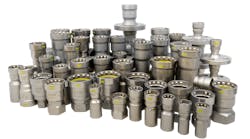WASHINGTON — Right before Christmas, the U.S. Department of Energy announced in a posting in the Federal Register that it is ending Federal preemption of state water conservation regulations. Now the industry is trying to figure out what the ramifications will be.
Will the industry be faced with a plethora of state water conservation laws or will it settle down to just a few? What’s the future of the EPA WaterSense program? What will happen to DOE’s proposal to ban multi-head showers?
On Dec. 22, 2010, DOE’s Office of Energy Efficiency and Renewable Energy issued a final rule titled, “Energy Efficiency Program for Consumer Products: Waiver of Federal Preemption of State Regulations Concerning the Water Use or Water Efficiency of Showerheads, Faucets, Water Closets and Urinals.”
The demise of Federal preemption over state water conservation laws was actually a widely known secret for almost 10 years. The waiver applies to any state regulation concerning the water use or water efficiency of faucets, showerheads, water closets and urinals if the state regulation is more stringent than Federal regulation. DOE noted in its posting that the Energy Policy and Conservation Act (EPCA) established a program for testing, labeling, and Federal energy conservation standards that reference the American Society of Mechanical Engineers (ASME)/American National Standards Institute (ANSI) standards A112.18.1M, for showerheads and faucets, and A112.19.6, for water closets and urinals.
DOE said the law requires that, not later than six months after the conclusion of a five-consecutive-year period during which the ANSI/ASME A112 committee has not amended the plumbing standards in order to improve water efficiency, DOE must waive Federal preemption of state laws or regulations. The last time the A112 Committee changed the standards was May 29, 1996, so Federal preemption technically ended in 2001.
That’s why manufacturers couldn’t squawk when states like California or Texas decided to go their own way on plumbing efficiency standards. Manufacturers decided, instead, to shepherd the process along by proposing more stringent efficiency standards, such as 1.28-gpf water closets, that they could live with.
Mark Malatesta, senior product compliance engineer for American Standard Brands, noted that different states might require different products, which can lead to SKU proliferation, along with inventory and manufacturing issues. He also said that states might choose to ignore WaterSense standards, bad news for the industry since WaterSense introduced performance requirements for plumbing fixtures, not just low-flow.
“Simply reducing water consumption requirements without considering the complete system can lead to adverse side effects, such as increased risk of scalding or thermal shock from shower valves, or the inability of existing drain lines to effectively carry waste into the sewage systems,” Malatesta said.
“Whenever I see something like that,” said Steve Lehtonen, executive director of GreenPlumbersUSA, “ I think there’s a full employment act for lobbyists all over the country.”
Manufacturers will have to fight for some semblance of uniformity in state laws, he noted. (Barbara Higgens, executive director of Plumbing Manufacturers International, has been adroit in lobbying state legislatures.)
“Our industry has been shortsighted,” Lehtonen said, in not updating efficiency standards and essentially forcing DOE’s hand. "If the industry can’t develop efficiency standards, we’ll now be stuck with having state legislators do it for us."
Conversely, Bill Erickson, chairman of C.J. Erickson Plumbing, Alsip, Ill., and chairman of the Green Technical Committee of the International Association of Plumbing & Mechanical Officials, said the industry and the market are way ahead of the government when it comes to plumbing efficiency.
“I would like to think that the DOE realizes that our industry has been making and installing water efficient faucets and fixtures for years and is doing a great job in researching and developing newer and better water saving faucets and fixtures all the time,” Erickson said.
Both Lehtonen and a code official who requested anonymity said WaterSense has enough traction that it will not be derailed. It will probably be the threshold for a number of state water efficiency laws.
Some states undoubtedly will stick with the baseline models codes from IAPMO and the International Code Council. Others will use the code bodies green code supplements, which rely on WaterSense standards. Jurisdictions such as Miami-Dade and California may be stricter. The California Energy Commission, for example, may move ahead with a ban on multi-head showers.
Last June, DOE announced that it was reinterpreting its showerhead rules in such a way that it would ban multi-head showers (July 2010, p. 1, and http://contractormag.com/news/doe-bans-multi-showerheads-2345/index.html). The move set off a storm of protest from contractors and manufacturers that DOE, with a single posting in the Federal Register and no notice, hearings or comment period, was outlawing an entire category of products that had been developed and marketed for 15 years.
DOE subsequently relented and solicited comments last fall. It was supposed to issue its final rule before Thanksgiving, then between Thanksgiving and Christmas, and then sometime early this year. What the Department will do remains to be seen.
Prominent plumbing engineer John Koeller, Koeller & Co., Yorba Linda, Calif., said he believes DOE will now either do nothing or issue a toothless standard. After DOE was bombarded with criticism for the proposed showerhead standard, it found itself embroiled in a controversy that it did not anticipate.
“The easiest escape for DOE is to say, ‘We are no longer the governing authority,’ and that’s what the elimination of preemption does in plumbing standards,” Koeller said. “So you have this showerhead definition still sitting out there, but it doesn’t mean anything because states will do whatever they want. The easy way out is for them to throw up their hands and say preemption is out.”

